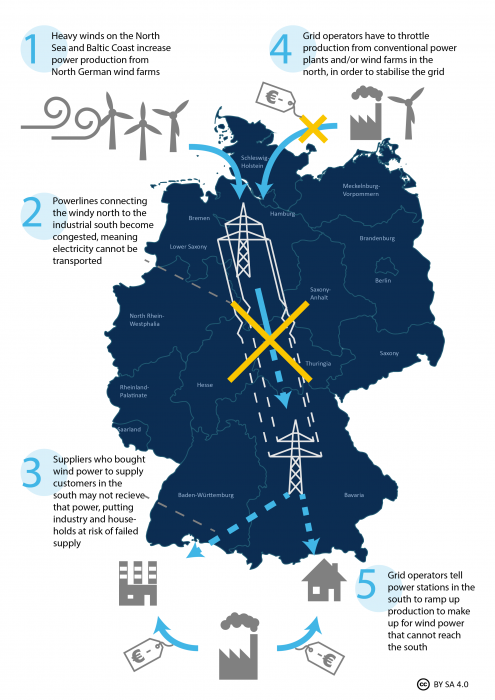Re-dispatch costs in the German power grid
Germany’s power system is increasingly based on fluctuating renewable energy sources, and that’s creating challenges for the country’s grid operators. In the old days, conventional power was supplied to meet demand. Now, a change of weather can result in a sudden influx of electricity. Operators have to work hard to keep the grid stable, through “re-dispatch” measures that ensure a balance between supply and demand.
The easiest way to illustrate this is with what happens on very stormy days in north Germany.
Germany’s energy transition is taking wind power production to new record highs. In 2015, the share of wind in total Germany’s total energy consumption rose by 50 percent. Onshore wind capacity expanded by 3.3 GW, and offshore capacity by 2.2 GW during that time. In February 2016, wind farms generated an unprecedented 33 gigawatts (GW) of electricity on a single day.
All that additional power has to go somewhere – and often its needed most in Germany's industrial south. On particularly windy days when demand in the north is low, this means renewable electricity fed into the grid exceeds the capacity of the power lines that are supposed to transport electricity to the south of the country. A kind of congestion occurs, forcing grid operators to take re-dispatch measures in order to stabilise the network.
For a power network to remain stable, the amount of electricity fed into the grid must equal that being drawn out of it, at any point in time. This is normally achieved through the power market, with power plant operators producing enough electricity to meet demand – i.e. supplying what has already been sold on the exchange (See CLEW factsheet merit order effect). Grid operators receive a power plant “dispatch” list, based on the market figures a day ahead, allowing them to check whether adjustments are needed to ensure the network runs smoothly.
If on a stormy day the north-south power lines are too congested to deliver wind power that has been bought in the south, grid operators can resort to three different types of re-dispatch measure:
- They can order conventional power stations in north Germany to reduce generation, in order to “make space” in the grid for the high influx of wind power
- They can temporarily shut down wind turbines (only as a last resort, because renewables have grid priority)
- They can order conventional power stations in south Germany to produce more electricity to meet demand from consumers in the south whose suppliers bought north German wind power that can’t get through.
All of these re-dispatch measures result in extra costs for consumers:
- When grid operators tell power stations to limit production, they must compensate them for the power they would have been paid for supplying (minus expenses the power plants save on fuel)
- When grid operators order renewable power producers to disconnect from the network, they too must be compensated for some of their lost profit
- Conventional power stations in south Germany that grid operators call on to produce extra power, do so at costs higher than the market price.
In 2014, re-dispatch interventions were necessary on 330 days (232 in 2013), concerning 5,197 gigawatt-hours (GWh) of power, and costing 186.7 million euros (132.6 million in 2013), the Federal Network Agency reports (p.100 monitoring report 2015).
In 2014 renewable power producers were paid an estimated 183 million euros in compensation for the feed-in management of their installations. This was to cover 1,581 GWh of renewable power that could not be fed onto the grid. But the network agency points out that this accounted for just 1.35 percent of the total net power generated from renewable sources in 2014. Compared to the total sum paid out for renewable power – 24 billion euros in 2015 – this represents only a small proportion of the costs linked to the growth of renewables in Germany.
In 2015, re-dispatch measures in Germany cost an estimated 402.5 million euros, according to transmission grid operators' estimates. Jochen Homann, president of the Federal Network Agency, has warned the annual figure could rise to 1 billion euros by 2020.
Re-dispatch costs are passed on to consumers as part of the grid fee households pay via their electricity bills.
Despite the frequent need for grid stabilising measures, the German power grid is one of the most reliable in Europe. The average consumer faces power outages of around 12 minutes per year, most of which have nothing to do with the feed-in of renewables (See a factsheet on grid stability here.)
Grid operators and the Federal Network Agency, as well as industry associations and renewable producers, are calling for swift grid expansion to help avoid bottlenecks in the north-south connections. The Federal Network Agency has indicated the need to refurbish 3,050 km of power lines, and build 2,750 km of new connections by 2024 (p. 21 monitoring report).
Some researchers argue that new north-south connections would never have enough capacity to absorb the growing wind power generation in the north and the decreasing conventional capacity in the south – where many nuclear power plants will go offline in the next seven years. They argue for measures such as a more decentralised power supply, power storage, demand-side flexibility, or even splitting the German power market into two different price zones.
See a CLEW dossier on the German power grid here.
See a CLEW article on loop-flows around the German grid here.


